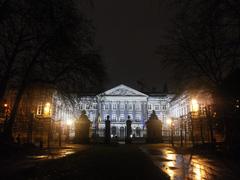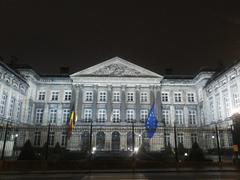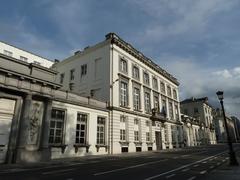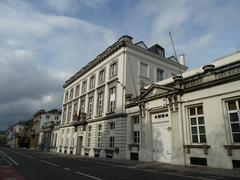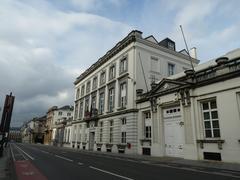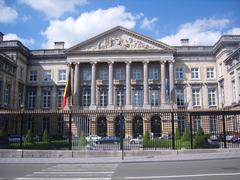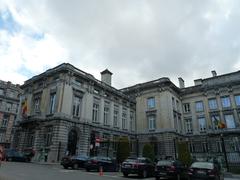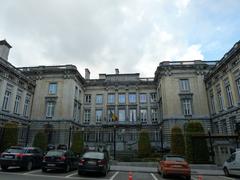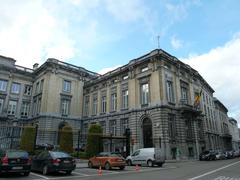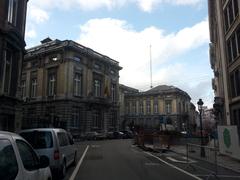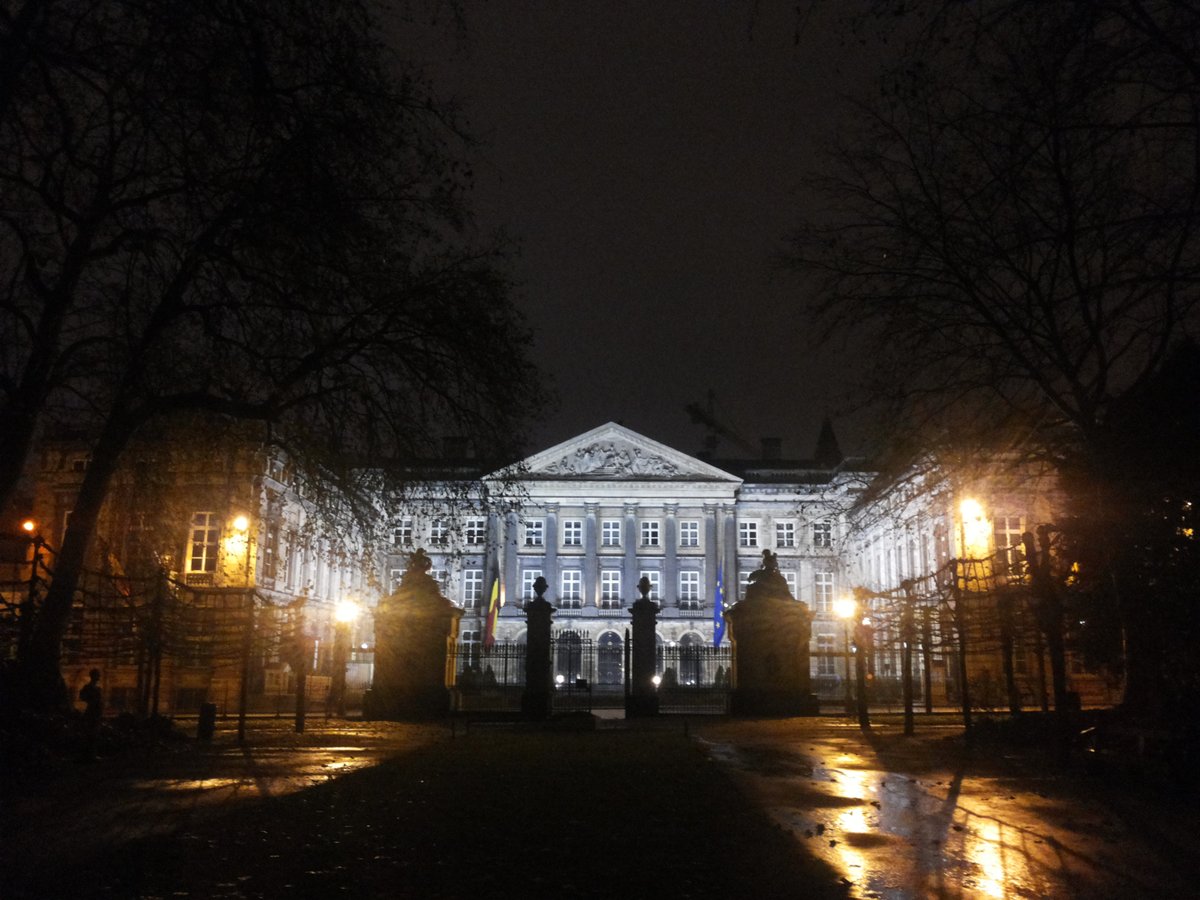
Palace of the Nation Brussels: Visiting Hours, Tickets, and Historical Information
Date: 14/06/2025
Introduction
The Palace of the Nation in Brussels stands as a monumental symbol of Belgium’s political heritage, architectural grandeur, and cultural identity. Situated at the northern edge of Brussels Park and facing the Royal Palace, this neoclassical masterpiece houses the Belgian Federal Parliament and offers a profound insight into the nation’s journey from Enlightenment ideals to modern democracy. Designed by French architect Gilles-Barnabé Guimard and commissioned by Empress Maria Theresa of Austria in the late 18th century, the palace has been at the heart of every key moment in Belgian political history—from the drafting of the first constitution to the present day.
While public access is generally limited, guided tours provide a rare opportunity to explore its richly adorned interiors, legislative chambers, and significant art collections. For travelers seeking the most accurate and current information on visiting hours, tickets, and accessibility, official resources like the Belgian Senate Visitor’s Guide and the Palace of the Nation official website are invaluable. Whether you’re interested in history, architecture, or Belgium’s ongoing democratic legacy, a visit promises a rewarding experience (source 1, source 2).
Table of Contents
- Origins and Early History
- Transformations Under Foreign Rule
- Birthplace of Belgian Independence
- Architectural Evolution and Restoration
- Visiting the Palace: Hours, Tickets, and Tours
- Nearby Attractions and Travel Tips
- Architectural Context and Surroundings
- Preservation and Legacy
- Frequently Asked Questions (FAQ)
- Conclusion
- References and Official Sources
Origins and Early History
Built between 1778 and 1783 under Austrian rule, the Palace of the Nation (French: Palais de la Nation; Dutch: Paleis der Natie) was commissioned by Empress Maria Theresa as the seat of the Sovereign Council of Brabant. Gilles-Barnabé Guimard’s neoclassical design, with its balanced symmetry, grand Corinthian columns, and stately façade, reflected Enlightenment ideals and the aspirations of the late 18th-century Belgian elite.
Transformations Under Foreign Rule
After the French Revolution brought Brussels under French control in 1794, the palace served as a courthouse and temporary lodging for visitors in a section known as the “Hôtel des Étrangers.” Following the defeat of Napoleon, the region became part of the United Kingdom of the Netherlands, and the palace was repurposed as the Dutch parliament’s seat, marking its first use as a legislative chamber.
Birthplace of Belgian Independence
The palace played a pivotal role in the Belgian Revolution of 1830, housing the provisional government and the National Congress that drafted Belgium’s first constitution. On November 18, 1830, Belgium was declared an independent constitutional monarchy within these walls. Since then, the building has continuously housed the Belgian Federal Parliament, including both the Chamber of Representatives and the Senate.
Architectural Evolution and Restoration
The palace’s neoclassical exterior has remained largely unchanged, but its interiors have been renovated several times due to fires in 1820 and 1883, and updated for modern needs. The original white plaster exterior was altered with roughcast in 1920. The building features a central section flanked by two wings: the Senate on the left and the Chamber of Representatives on the right. In the 1930s, a secure bunker was constructed beneath Brussels Park to enhance national security.
Visiting the Palace: Hours, Tickets, and Tours
- Visiting Hours: The Palace of the Nation is generally open to the public only for guided tours by appointment, typically on weekdays. Special openings may occur during parliamentary recesses or on Heritage Days. Always consult the official website or Senate Visitor’s Guide for current schedules.
- Tickets: Admission for guided tours is free, but advance booking is required. Valid identification is necessary due to security procedures.
- Guided Tours: Tours provide in-depth insights into the palace’s history, architecture, and political significance, including visits to the legislative chambers.
- Accessibility: The palace is accessible to visitors with reduced mobility. Notify visitor services during booking to ensure proper arrangements.
Nearby Attractions and Travel Tips
The Palace of the Nation is centrally located near other major Brussels landmarks:
- Royal Palace of Brussels
- Brussels Park
- BELvue Museum
- Place Royale-Koningsplein
Tips:
- Use public transport (Parc/Park or Arts-Loi/Kunst-Wet metro stations) for easy access.
- Wear comfortable shoes for walking.
- Book tours in advance, especially during the summer or on special event days.
Architectural Context and Surroundings
The Palace of the Nation is a cornerstone of Brussels’ neoclassical urban ensemble, rebuilt after the destruction of the medieval Coudenberg Palace in 1731. Its strategic position facing the Royal Palace across Brussels Park symbolizes the balance between monarchy and democracy. The palace’s dignified restraint stands in contrast to Brussels’ Gothic, Baroque, and Art Nouveau landmarks, reflecting Enlightenment values of rationality and civic virtue (theurgetowander.com).
Preservation and Legacy
Despite fires and political upheaval, the Palace of the Nation has endured as a resilient emblem of Belgian statehood. Ongoing conservation efforts ensure the preservation of its artistic and architectural treasures, while also adapting the building for modern accessibility and sustainability (mytripwise.com).
Frequently Asked Questions (FAQ)
Q: What are the Palace of the Nation’s visiting hours?
A: Generally, guided tours are available by appointment on weekdays. Check the official website or Senate Visitor’s Guide for specific dates and times.
Q: How do I book a tour?
A: Reserve your spot via the Senate’s visitor services online or by email.
Q: Is the palace accessible for visitors with disabilities?
A: Yes, with prior notice, accessibility arrangements can be made.
Q: Are tickets required?
A: Guided tours are free but require advance registration and identification for security.
Q: Can I visit the palace without a tour?
A: No, independent visits are not permitted; guided tours are the only way to access the building.
Q: Are tours available in English?
A: Yes, tours are offered in English, French, and Dutch.
Q: Can I take photos inside?
A: Photography is permitted in some areas, but restrictions may apply in legislative chambers.
Conclusion
The Palace of the Nation stands as a vital emblem of Belgium’s democratic values and historical resilience. From its 18th-century origins to its pivotal role in the Belgian Revolution and its ongoing function as the seat of the Federal Parliament, the palace offers visitors a unique opportunity to explore the nation’s political and cultural evolution. Guided tours illuminate its architectural splendor, artistic treasures, and living legacy at the heart of Belgian democracy.
Located amid other significant Brussels landmarks, the palace is an essential destination for anyone seeking to understand Belgium’s history and civic life. To ensure a seamless experience, consult official schedules, reserve tours in advance, and consider exploring nearby sites. Utilize resources like the Audiala app for enriched, personalized guidance throughout your visit.
For the most up-to-date information, refer to the Senate’s visitor services and the Chamber of Representatives. The Palace of the Nation continues to inspire and welcome those eager to connect with Belgium’s national story (source 1, source 2).
References and Official Sources
- Senate Visitor’s Guide (PDF)
- Brussels Through Architecture
- Official Palace of the Nation Website
- Visit Brussels Tourism
- Brussels historical sites overview
- Brussels.com: History
- TravelTriangle: Belgium in June
- MyTripWise: Guided Tours
- World Cities Culture Forum: Brussels
- Brussels Express: UNESCO Legacies
- FlyAlong: Royal Palace of Brussels
- The Crazy Tourist: Best Things in Brussels
- Trip.com: Royal Palace of Brussels
